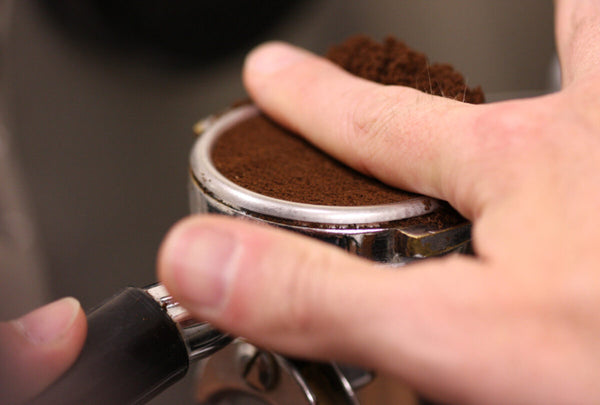Distributing coffee grinds is always at the centre of many baristi debates. A barista is the public face of specialty coffee, and it is up to him or her to translate the coffee’s best characteristics into the cup for the customer.
A café barista can only be expected to work with what is available to them, meaning that decisions about machinery and coffee supply are extremely important for owners. The basics of coffee preparation, things like grinding to order, not re-steaming milk, pre-heating cups, cleanliness and so on, have, for the most part, become common practice. This makes techniques such as distribution, dosing and particle size very valuable, as they are some of the few variables that remain open for barista interpretation.
Firstly, before considering what technique to use, we must understand that the goal of distribution is to create a uniform bed of coffee in the portafilter basket (‘PF’). Assuming we achieve this, combined with correct particle size and dose, the following application of pressurised water would then result in an even saturation and thus an even extraction of the coffee grinds. If you have ever used a bottomless portafilter, I am sure you will concur that this is much easier said than done! However, baristi must remember, the success of the extraction is directly responsible for achieving the correct flavour profile in the cup. Many times, flavours associated with over or under-extraction, such as bitterness, sourness, burnt or watery coffee, are wrongly attributed to the bean or the roast.
The focus of this article is distribution and here I take a quick look at some of the more widely known distribution techniques.
Chicago Chop
Begin by slightly over-dosing the PF so that you have a small mound of coffee on top. Use the back of a butter knife or a similar coffee tool to ‘chop’ across the coffee bed in a single direction and then repeat in the perpendicular direction. Scrape across the basket to level the grounds, tamp and insert. This method is obviously much easier to explain and, most importantly, has a high level of repeatability among baristi. It might be a bit less flashy; however, it’s likely to be a more effective way of achieving consistency in a café. Although this technique is dubbed the ‘Chicago Chop’ or ‘Intelligentsia Method’, I have seen many baristi and even first time home users instinctively use a variation of this method when handed a knife to dose.
Schomer’s NSEW
Begin by slightly over-dosing and using your finger or coffee tool to push the grinds in a North / South and then East / West direction, swiping off any excess in the last move. This is another easily learned and repeatable method. However, using your finger can sometimes lead to different baristi applying variable amounts of pressure, thus affecting the dose. If you decided to use this method in your café, I would suggest using a knife or coffee tool, as using your finger does not always create the right image in the eye of the consumer!
Stockfleth’s Move
Begin by slightly over-dosing and place the PF head close to your body, around your midsection. Looking down, your left arm holding the PF should now be in an almost right angle position, away from the body, with your elbow pointing outwards. Now imagine making a fake gun with your right hand, turning it flat and positioning your thumb on the rim of the PF closest to the right lug, with your index finger on top of the coffee bed. Looking down, both elbows should be pointing out in what feels like an awkward position for first timers. The motion is one that brings your elbows to your sides, your wrists together and runs your thumb along the rim of the PF and then over the left lug to centre the grinds. All this while using the index finger in a circular motion on top of the coffee bed, and then finishing with a swipe. Confused yet?! It certainly is a very hard technique to communicate and even harder to learn without hands on instruction. Because of this, the Stockfleth’s move has morphed into many different variations.
Shyndel Method
Again, begin by slightly over-dosing and creating a small mound of coffee in the PF. Rest your index and middle finger on the PF in a V shape and complete a light sweep in a circular motion. Repeat the motion again and you should be left with some grinds in between your two fingers, swipe both fingers off to the side, levelling the grounds. Once again, continually applying a consistent amount of pressure is paramount to making this method repeatable and useable in a commercial environment.
It’s important that we remember our goals as well as our audience when it comes to distribution. It is, of course, natural for competition baristi to tweak their method in order to reduce waste, add flair and create something unique and repeatable for themselves. However, a commercially viable technique, which takes into account the human factor, speed, waste and repeatability is obviously more important for cafés.
Out of the four techniques listed above, I personally consider the ‘Chicago Chop’ or a variation thereof to be one of the more commercially friendly techniques. Last of all, the most important factor to remember is that distribution begins during dosing. Moving the portafilter back and forth during dosing will distribute the grinds as evenly as possible, giving you the foundation you need to establish a great distribution technique.



























